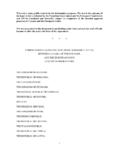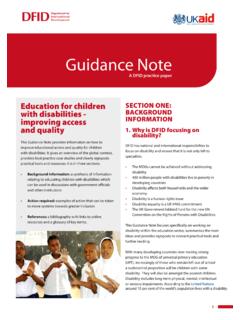Transcription of CULTURE, BELIEFS, AND DISABILITY - United Nations
1 CULTURE, BELIEFS, AND DISABILITYCULTURE, BELIEFS, AND DISABILITYT oolkit on DISABILITY for AFRICAM odule 13 - CULTURE, BELIEFS, AND DISABILITYiiiTOOLKIT ON DISABILITY FOR AFRICATABLE OF CONTENTS1. OVERVIEW ..12. TECHNICAL CONTENT .. Background .. Review of the Legal Framework ..3 Country Checkpoint .. Harmful Beliefs relating to DISABILITY ..5 Country Checkpoint .. Consequences of Harmful Beliefs regarding DISABILITY .. Measures to Combat Harmful Beliefs and Practices regarding DISABILITY Stigma ..8 Country Checkpoint ..103. SUMMARY & KEY LEARNING POINTS ..144. USEFUL RESOURCES ..155. LEARNING ACTIVITIES ..16 Session Sheet for the Trainer Culture, Beliefs, and DISABILITY , Session 1.
2 17 Learning Activity : Stereotypes/Myths about People with Disabilities ..18 Handout: Template Stereotypes about People with Disabilities ..19 Session Sheet for the Trainer Culture, Beliefs, and DISABILITY , Session 2 ..20 Learning Activity : Strategies & Campaigns to address Negative Stereotypes/Myths ..21 Handout: Case Studies (4) ..22 Module 13 - CULTURE, BELIEFS, AND DISABILITYivTOOLKIT ON DISABILITY FOR AFRICAA cknowledgements The Division for Social Policy and Development (DSPD) would like to thank all those who contributed to the Toolkit on DISABILITY for Africa, including the United Nations Office for the High Commissioner for Human Rights (OHCHR), the Economic Commission for Africa (ECA), the International Labour Office (ILO), the International Training Centre - ILO (ITCILO), the World Health Organisation (WHO), the African Union and the governments of Kenya, South Africa and Zambia.
3 DSPD also wishes to thank the Government of Italy for its financial support and the numerous African Disabled Peoples Organisations (DPOs) who contributed substantial input to the 13 - CULTURE, BELIEFS, AND DISABILITYvTOOLKIT ON DISABILITY FOR AFRICAList of acronymsAT Assistive TechnologyCEDAW Committee on the Elimination of Discrimination against WomenCEDAW Convention on the Elimination of All Forms of Discrimination against WomenCESCR Committee on Economic, Social and cultural RightsCRPD Convention on the Rights of Persons with DisabilitiesCRPD Committee on the Rights of Persons with DisabilitiesCRC Committee on the Rights of the ChildCRC Convention on the Rights of the ChildCRC Convention on the Rights of the ChildDFIs Development Financing InstitutionsDPOs Disabled Persons Organizations DSPD Division for Social Policy and Development/UNDESAEC European CommissionG3 ICT Global Initiative for Inclusive ICTsHIV/AIDS Human Immunodeficiency virus / Acquired Immunodeficiency SyndromeICCPR International Covenant on Civil and Political RightsICESCR International Covenant on Economic and cultural RightsICF
4 International Classification of Function, The World Health OrganizationICT Information and Communication TechnologyILO International Labour OrganizationITCILO International Training Centre of the ILOIPU Inter-Parliamentary UnionITC Information and Communication TechnologyITU International Telecommunication Union MDGs Millennium Development GoalsMFIs Microfinance institutionsMSPs Multi-stakeholder Partnerships NAPs National Action PlansNGO Non-Governmental OrganizationNVDA Non Visual Desktop Access OHCHR Office of the High Commissioner for Human RightsOSISA Open Society Initiative for Southern AfricaModule 13 - CULTURE, BELIEFS, AND DISABILITYviTOOLKIT ON DISABILITY FOR AFRICAPCM Project Cycle ManagementPRP Protracted Relief ProgrammeSABE Self-Advocates Becoming EmpoweredSDGs Sustainable Development Goals UDHR universal declaration of Human RightsUN United NationsUN DESA United Nations Department of Economic and Social AffairsUNAIDS Joint United Nations Programme on HIV/AIDSUNDP United Nations Development FundUNESCO United Nations Educational, Scientific and cultural OrganizationUNICEF United Nations Children's FundUSAID United States Agency for International DevelopmentVOCA Voice Output Communication AidsWHO World Health OrganizationModule 13 - CULTURE, BELIEFS.
5 AND DISABILITY1 TOOLKIT ON DISABILITY FOR AFRICA1. OVERVIEWM odule objectives To consider the causes and social consequences of harmful beliefs regarding DISABILITY and to identify concrete actions to overcome is this module for?This module is relevant to everyone with an interest in DISABILITY or a responsibility for addressing issues of DISABILITY because of the nature of their work, including persons with or without disabilities in civil society, civil and public service, national human rights institutions, parliaments, development agencies, universities and the private is this module about?The content of this module: explains that attitudes about DISABILITY vary and that in Africa there are examples both of positive and empowering views regarding DISABILITY , and also of negative or harmful views; reviews relevant obligations set forth in the Convention on the Rights of Persons with Disabilities (CRPD), including Article 8 on awareness-raising; examines the causes and social consequences of harmful beliefs relating to DISABILITY ; explains measures that may be taken to combat stigmatization and harmful practices relating to DISABILITY ; includes learning exercises to accompany the material; and lists key resources for additional reference.
6 ILO/ M. CrozetModule 13 - CULTURE, BELIEFS, AND DISABILITY2 TOOLKIT ON DISABILITY FOR AFRICAL earning objectivesOn completion of this module, participants will have:1. contributed to discussions on harmful beliefs regarding DISABILITY in an african context;2. contextualised the CRPD as an instrument to guide measures to combat harmful practices and beliefs related to DISABILITY ; 3. developed a strategy for tackling negative beliefs about people with map1. OVERVIEW2. TECHNICAL Review of the Legal Harmful Beliefs relating to Consequences of Harmful Beliefs regarding Measures to Combat Harmful Beliefs and Practices regarding DISABILITY Stigma3.
7 SUMMARY & KEY LEARNING POINTS4. USEFUL RESOURCES5. LEARNING ACTIVITIESM odule 13 - CULTURE, BELIEFS, AND DISABILITY3 TOOLKIT ON DISABILITY FOR AFRICA2. TECHNICAL BackgroundIn all regions of the world persons with disabilities face attitudinal barriers, including prejudice, low expectations and even fear. Negative attitudes about DISABILITY impact on all aspects of the lives of persons with disabilities, including the ability to access education, to participate in non-exploitative work, to live where and with whom one chooses, to marry and start a family, and to move about freely within the community. Attitudes to DISABILITY are not always uniform within a region or even within a country.
8 Different groups or individuals may have beliefs about DISABILITY that vary from those held by wider society and beliefs may vary even within small communities and within families. In African societies, as in societies in other regions, there are examples of positive and empowering beliefs about However, as is the case in many settings across the globe, DISABILITY is sometimes also associated with negative perceptions resulting in stigma, discrimination, exclusion and violence, as well as other forms of abuse of persons with disabilities. The present module focuses on understanding and addressing the latter context and also explores approaches to transforming negative perceptions and ending harmful practices towards persons with disabilities.
9 See Learning Activity titled Stereotypes/Myths about People with Review of the Legal FrameworkThe present module focuses on the causes and consequences of harmful beliefs regarding DISABILITY . International human rights law generally and the CRPD in particular, provide a number of relevant forms of protection, including prohibition of all forms of discrimination on grounds of DISABILITY . The CRPD requires State parties to guarantee the right to non-discrimination under the law and to undertake all appropriate measures to eliminate discrimination on the basis of DISABILITY by any person, organization or private enterprise. Article 4 of the Convention sets out the general obligations of State parties, which include the adoption or modification of relevant law and policy to ensure and promote the full realization of all human rights and fundamental freedoms for persons with disabilities, without discrimination of any kind.
10 Article 4 further stipulates that State parties must closely consult with and actively involve persons with disabilities through their representative organizations in the development and implementation of relevant legislative, policy and other decision-making processes. The participation of persons with disabilities, which is a general principle of the CRPD (art. 3(c)), is central to ensuring 1 See, for example, Chomba Wa Munyi, Past and Present Perceptions Towards DISABILITY : A Historical Perspective, DISABILITY Studies Quarterly, available at: ; Angie Stone-MacDonald, cultural Beliefs and Attitudes about DISABILITY in East Africa (2014), Review of DISABILITY Studies: An International Journal, available at.















